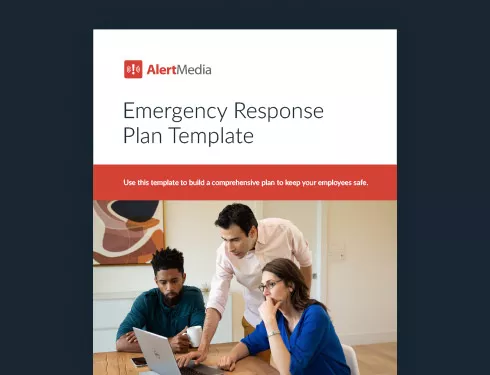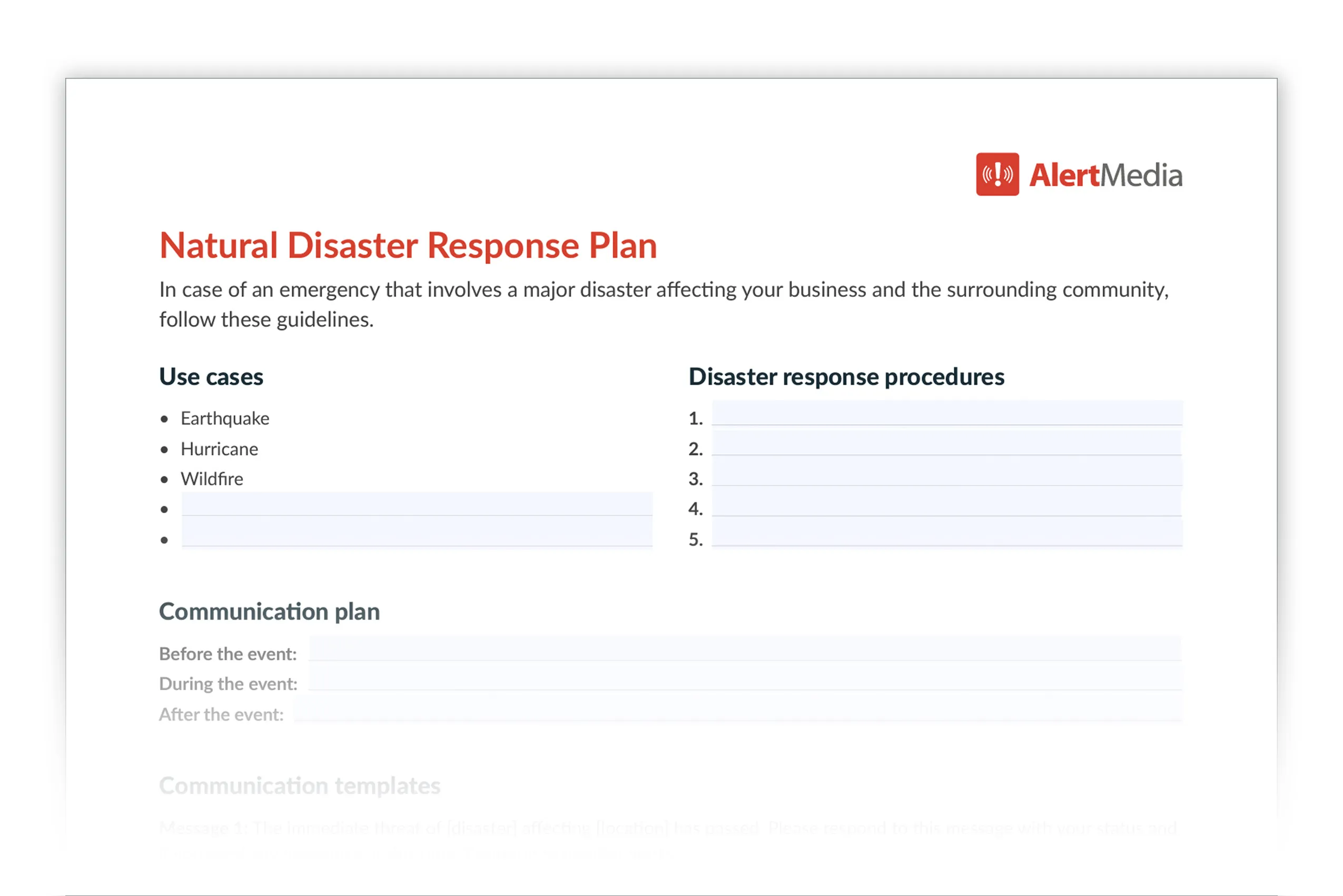
9 Steps to Creating an Effective Emergency Response Plan [+ Template]
Minutes can mean the difference between effective emergency management and a catastrophic disaster. Develop a comprehensive emergency and disaster response plan to safeguard your people, business, and assets during any critical event that may occur.

How will your team respond during a crisis? Emergency response plans are essential, but their effectiveness depends on preparation and testing. Private sector employers face over 2.5 million workplace incidents annually, alongside disasters, operational disruptions, cyberattacks, and other incidents. A strong disaster response plan must be straightforward enough to execute under pressure while ensuring everyone understands how their role supports recovery efforts and business continuity.
Proactive emergency response planning creates room for practice and improvement. By identifying risks, assigning clear roles, and refining procedures, you can ensure your team is ready to act effectively in critical moments. Here’s how to develop a plan that works when it counts.
Download Our Emergency Response Plan Template
What Is an Emergency Response Plan?
An emergency response plan details your organization’s steps during a critical event, such as a fire or active shooter threat. It ensures employee safety and reduces the impact on emergency operations.
Preview of our Emergency Response Plan Template
These plans—just like other emergency management planning documents—are meant to help organizations address various types of threats, such as hurricanes, wildfires, winter weather, chemical spills, disease outbreaks, and other hazards. The goal is to reduce or prevent human injury and property damage during critical events. In the planning phase, you will document your organization’s detailed steps in each emergency scenario.
These emergency action plans also take the guesswork out of roles and responsibilities by specifying which staff members should be part of the response team and which first responders you should contact.
You can create your emergency response plan from scratch or use a pre-built template, like ours, to make the process easier.
Comparing various response plan types
You may often hear the term emergency response plan mentioned alongside two other disaster preparedness frameworks: disaster response plans and incident response plans. While these terms are sometimes used interchangeably, they each serve distinct purposes with key differences.
| Emergency response plan | Disaster response plan | Incident response plan |
|
|
|
FEMA’s CPG framework: Standardized emergency management
Any discussion about the different types of disaster preparedness or response plans should incorporate the Federal Emergency Management Agency’s (FEMA) Comprehensive Preparedness Guides (CPG) framework. This series of guidance documents supports planning efforts across public and private sector organizations.
The most widely used guide in the CPG framework is CPG 101, which addresses the foundational aspects of emergency preparedness and planning. It emphasizes an all-hazards approach to mitigate risks from different types of emergencies ranging from technological incidents to natural disasters and human-made events. This guide provides checklists and examples to assist in the planning process. It also incorporates templates that organizations can adapt to implement a standardized framework tailored to their unique needs in different emergency situations.
Why use an emergency response plan template?
An emergency response plan template can simplify and streamline your planning process. Every business faces a unique range of emergencies, but there are some consistent response procedures you can personalize to your risks. Templates also give you a single place to collect necessary contact information for your response team and first responders.
You can download this free template to get started building your plan today.
The best emergency response plans include a list of individuals to contact (and their contact information), evacuation routes, how to act during an emergency, how to mitigate risk to your people and facilities, and detailed communication procedures to follow during and after a specific emergency occurs.
That said, disaster response plans can vary widely depending on the setting and circumstances surrounding the crisis. Create a plan that accounts for life-saving actions, such as
- Evacuating buildings during events like fires
- Ordering shelter-in-place during severe weather like tornadoes
- Locking down the workplace during active shooter situations
- Providing medical services during workplace accidents or sudden health crises
- Offering disaster assistance for employees after disruptions like floods or fires
- Containing hazardous materials during chemical spills or gas leaks
- Maintaining operations during power outages, cyberattacks, or supply chain interruptions
- Coordinating transportation to evacuate employees or relocate resources during emergencies
- Distributing food, water, or medical kits during prolonged emergencies
Now that you’re up to speed on why your organization needs a plan and what it should cover, let’s examine how to create an effective emergency response plan for your business.
How to Conduct Disaster and Emergency Response Planning
Each organization is unique, so you may find that additional measures are warranted to protect your business from possible hazards—beyond the examples listed. However, by completing these steps, you will be well on your way to ensuring your team knows what you expect of them and when.
Step #1: Perform a risk assessment

The first step to creating an emergency response plan is to conduct a comprehensive threat assessment to identify the types of emergencies that may affect your organization and analyze their likelihood and potential impact. Specific threats vary by location, sector, and company—your mitigation strategies and protective actions will vary depending on the scenario. You may need to plan for the following risks:
- Natural disasters — Hurricanes, tornadoes, earthquakes, wildfires, etc.
- Severe weather — Winter storms, high winds, extreme heat waves, floods, etc.
- Pandemics and infectious diseases — COVID-19, influenza, etc.
- Facility emergencies — Structure fires, hazardous leaks or spills, etc.
- Acts of workplace violence — Active shooters, bomb threats, domestic violence, etc.
- Civil disturbances — Protests, demonstrations, riots, strikes, etc.
Even when lives may not be immediately at stake during the stages of a crisis, timely communication is just as important. Other events that require a planned response for the business’s success and your team’s safety may include financial, IT, operational, and crisis communication incidents.
Disaster financial management planning
Every disaster can be a financial disaster, making disaster financial management essential for protecting your organization’s stability. Start by assessing potential costs and building an emergency fund to cover immediate needs. Securing the right insurance can help offset significant losses, while pre-negotiated vendor contracts ensure quick access to critical services without unexpected expenses. During an emergency, tracking expenses in real time allows you to stay organized and submit accurate reimbursement claims. Additionally, exploring government grants or loans can provide much-needed relief in recovery.
Cybersecurity and IT events
IT events like unplanned outages, planned maintenance, system testing, cyberattacks, or security breaches can disrupt your operations without warning. Prepare by developing an IT incident response plan that outlines clear steps for addressing each scenario. Implement robust monitoring tools to detect issues early and ensure you have a communication plan to notify employees and stakeholders of impacts. Pre-schedule maintenance and testing to minimize downtime and maintain backups of critical systems and data to prevent loss during outages. For cyberattacks, include containment, investigation, and recovery protocols to protect your systems and data.
Operational disruptions
Logistics disruptions—such as power outages, equipment failures, office closures, travel advisories, and shift scheduling issues—can significantly impact your operations. To prepare, develop a response plan outlining actions for each scenario type. For power outages, identify backup power sources or alternative work locations. You can address equipment malfunctions by maintaining vendor relationships for quick replacements or repairs. Safety alerts and travel advisories should trigger clear communication protocols to keep employees informed. A flexible scheduling system also ensures you can quickly adjust shifts or allocate overtime as needed to support your operations plan.
Corporate/crisis communication
Corporate crises like product recalls, negative publicity, layoffs, or major company announcements can significantly impact your organization’s reputation and operations. Preparing a crisis communication plan ensures you can respond quickly and effectively. Designate a spokesperson to maintain a consistent and clear message and develop templates for press releases, employee updates, and stakeholder communications. This will keep everyone consistent and on the same message. At the same time, monitor public sentiment and media coverage to adapt your strategy as needed.
Taking an all-hazards approach
All of the scenarios mentioned above fit into an all-hazards approach to risk assessment and mitigation. This comprehensive strategy helps you address a wide range of potential threats, ensuring your organization is prepared for any situation that might arise.
Step #2: Decide how to communicate with your employees
An emergency communication plan is one of the most critical components of any emergency response. It ensures you can notify employees quickly, deliver information clearly, and reach everyone in harm’s way through reliable channels.
Traditional methods like phone trees often fail. Phone trees can cause delays and spread misinformation. Frontline workers without email access or personal devices are especially vulnerable. Relying on email alone in emergencies like IT outages can render your emergency communication plan ineffective.
A strong example of how an emergency communication plan can make or break your response comes from Whataburger. In an interview on The Employee Safety Podcast, Corporate Senior Emergency Manager Ron Derrick shared insights into the company’s robust communication process and how it ensures safety and operational continuity for over 50,000 employees across 860 locations in 14 states.
Whataburger’s approach centers on their 24/7 contact center, which Derrick describes as the company’s 9-1-1. This emergency operations center receives reports from restaurants, triages incidents, and escalates critical situations to its command center. The command center uses 23 detailed playbooks to guide responses step by step, including activating a core incident management team when necessary. Derrick emphasized, “The command center is considered the voice of truth. Every communication follows a communications matrix to ensure the right message reaches the right people through the appropriate channels.”
This communication matrix proved invaluable during a severe tornado outbreak in Central Texas. Instead of sending individual alerts for each tornado warning, Whataburger used a mass communication system to instantly notify employees and leaders across affected regions. “That mass communication tool was literally a lifesaver,” Derrick explained.
Of course, such a system is only as good as its data. That’s why another critical step is to consistently document contact information for public safety officials and team members who may be affected by the situation.
Step #3: Document contact information
In an emergency that could cause physical harm to your employees, the first call you should make is to your local emergency responders. Beyond dialing 9-1-1, ensure you have direct contact numbers for emergency medical services (EMS), the fire department, healthcare providers or insurance agents, local government offices, and law enforcement for that jurisdiction readily accessible.
Additionally, regularly update emergency contact information for every employee to ensure it remains accurate and reliable in case someone is injured or unaccounted for during an emergency. Aim to review and refresh this information annually or more frequently and prioritize updates ahead of potential disasters, such as severe weather events or natural disasters. Keeping phone numbers current helps avoid delays and ensures you can quickly notify the appropriate individuals when it matters most.
Step #4: Assign roles and responsibilities
Employees will look to their leaders for reassurance and guidance during an emergency. These leaders should be responsible for activating your emergency response plan, answering questions, and ordering an evacuation if needed. When assigning roles, there are essential considerations to acknowledge. You must ensure your response team is present, reliable, and can react quickly in an emergency.
Here are the leading roles to consider as part of your emergency response plan:
Emergency response team roles and responsibilities
Incident commander
This employee has overall responsibility for an emergency, including planning and preparation. The incident commander is in charge of emergency response plan activation and is the one all critical decisions should go through.
Communication commander
This person should use the mass alert system to notify employees, call emergency services, and gather reports. If your company uses an emergency communication system, ensure this person is a system admin.
Scene supervisor
This person controls access to the emergency scene and keeps people away from unsafe areas.
Building utilities manager(s)
These team members need to be familiar with the locations and functions of controls for building utility and life safety and protection systems. These systems include ventilation, electrical shutoffs, water and sanitary systems, emergency power supplies, and alarm systems.
Route guide(s)
In the event of an evacuation, these guides play an essential role in ensuring that routes are clear and the path to safety is orderly and calm. They also help clear evacuation routes and assist those with mobility issues.
Step #5: Develop protective actions for life safety
A life safety plan is the most critical and immediate part of an emergency response plan. As the name implies, its goal is to protect human life during and immediately after an incident. This life safety plan is not just internal; it’s also an essential procedure for the first responders arriving to render aid.
Specifically, a life safety plan includes a complete building layout, identifying all exits, emergency equipment, and potential hazards. It ensures that everyone—employees, visitors, and first responders—has clear instructions on what to do in an emergency.
The plan guides whether evacuation, shelter-in-place, or lockdown is the safest course of action, depending on the circumstances. Each option has specific criteria and considerations. For example, evacuation may be necessary during fires, gas leaks, or structural risks, while shelter-in-place is often the safest response to severe weather events or chemical spills. On the other hand, a lockdown is typically required during active threat situations where securing individuals in a safe location is paramount to reducing risk.
Organizations must assess the specific risks of various scenarios to determine the best times and methods for implementing evacuation, shelter-in-place, or lockdown procedures. The plan should detail these protocols to ensure readiness, especially if two-way communication is unavailable during an incident.
Step #6: Take stock of current resources within your organization
Have you inspected those dusty office fire extinguishers, alarm systems, or first aid kits lately? These are critical components of any emergency response plan, so examine them regularly.
Fire extinguishers and alarms
To enhance fire safety in the workplace, follow recommendations from the National Fire Protection Association, such as refilling reusable fire extinguishers every 10 years and replacing disposable ones every 12 years. Regularly remind employees of fire extinguisher locations and ensure fire alarms are properly maintained and tested. Incorporating routine fire drills can also help familiarize your team with the evacuation process, making them better prepared in an emergency.
Alarm systems
Inspect fire alarm systems annually, at the very least. OSHA recommends testing non-supervised employee alarm systems every two months. Depending on the type of alarm system, this inspection covers a host of details, like inspection of the control panel(s), tests of all associated devices such as smoke and heat detectors, warning systems operations, and batteries and power.
First aid kit
OSHA requires that “employers provide medical and first aid supplies commensurate with the hazards of the workplace.” Since many items in a first aid kit have expiration dates—typically three to five years after manufacture—and can become damaged by frequent use, moisture, and exposure to the air, it is vital to regularly check your first aid kit and replace any supplies as needed. As a proactive approach, restock items after use and inspect first aid supplies every three months. Provide the necessary first aid training so your team is prepared to use these supplies and help their coworkers in emergencies, big and small.

Step #7: Determine your response plan steps
Next, decide what steps to follow in an emergency. Customize each event response so the procedures are specific and clear.
For example, here’s how you might plan for an evacuation response.
Emergency fire evacuation plan example
A good fire evacuation plan for your business will include primary and secondary escape routes.
- Mark all the exit routes and fire escapes with signs.
- Keep exit routes clear of furniture or other objects that could impede your employees’ direct means of egress.
- Make multiple maps of floor plans and diagrams for large offices and post them so employees know the evacuation routes.
- Develop a separate evacuation plan for individuals with disabilities needing additional assistance.
Once your people are out of the building, where do they go?
- Designate an assembly point for employees to gather.
- Your response team should be at the assembly point, collecting a headcount and providing updates.
- Ensure the escape routes and the assembly area can accommodate the expected number of employees who will be evacuating.
Don’t overlook disaster recovery—what happens after the crisis settles. Planning for recovery ensures your business can resume normal operations as quickly as possible. Create a detailed disaster recovery plan with a checklist to keep your team aligned and their efforts coordinated. For example, in the case of a hazardous materials spill, your emergency response plan will focus on keeping people safe and containing the spill. Recovery efforts will outline steps to clean up the spill and restore the affected area to safe working conditions.
Include notification templates in your emergency response plan to send messages about an incident as quickly as hitting a button. Our template includes examples of what those messages might look like and spaces to compose your own.
Step #8: Conduct exercises for plan practice
If you don’t practice your plan during downtime, your only option is to test it when disaster strikes—and emotions will be running high. Consider different methods for reviewing your strategy and identifying gaps to avoid this risky approach. Informal walkthroughs and disaster recovery tabletop exercises allow you to test your theories in a low-pressure environment. In contrast, functional exercises and full-scale drills provide hands-on experience to ensure your plan works effectively under real-world conditions.
Walkthroughs
Walkthroughs involve guiding key personnel step-by-step through the emergency response plan to ensure everyone fully understands their roles and responsibilities. For example, a facilities manager might lead department heads through evacuation routes, pointing out assembly points, supply locations, and communication platforms. This process allows participants to visualize the plan from the employees’ perspective and identify potential obstacles or issues that might arise during an emergency.
| Pros | Cons |
|
|
Tabletop exercises
A tabletop exercise is more formal than a walkthrough, serving as a discussion-based simulation that allows participants to think through their responses to a hypothetical scenario. For example, in a cybersecurity incident test, the team might discuss a ransomware attack, outlining steps to isolate the affected system, notify leadership, and restore data backups. This method emphasizes coordination, communication, and decision-making under pressure, helping to identify gaps in the plan and improve disaster preparedness.
| Pros | Cons |
|
|
Functional exercises
Functional exercises typically focus on a specific aspect of emergency preparedness, such as operating equipment. Ahead of natural disasters, organizations often test their communication platform to ensure employees can receive instructions and respond appropriately. This exercise provides a controlled environment to familiarize participants with the system, identify potential issues, and address any communication lapses before an emergency occurs.
| Pros | Cons |
|
|
Full-scale exercises
Full-scale exercises simulate real emergencies by integrating multiple teams and public emergency services into a comprehensive and realistic test of your emergency response plan. These exercises replicate the conditions of a true crisis, requiring participants to act in real-time and collaborate with external stakeholders like police, firefighters, emergency medical services, and even government agencies.
For example, an active shooter drill might involve the local police coordinating with your organization’s security team to neutralize the threat, while fire departments assist with evacuations and EMS provides medical aid to mock victims. This type of drill tests your organization’s internal communication and evacuation procedures and the effectiveness of collaboration with first responders.
| Pros | Cons |
|
|
Since each training type has pros and cons, the most effective approach is to use a combination of all of them. By scaling up from walkthroughs to tabletop exercises, functional exercises, and full-scale drills, your team can gradually build the skills and confidence needed to handle any incident effectively.
Step #9: Establish performance objectives and metrics
How do you know if your disaster or emergency response plan is practical? You need to test it against benchmarks to evaluate your response and identify weaknesses. Some of the most common metrics used in disaster response include:
- Recovery time objective (RTO): The targeted timeframe to restore critical operations after an incident
- Recovery point objective (RPO): This IT term references the maximum acceptable duration of data loss before significant operational impact
- Evacuation time: The time required to safely evacuate all individuals during drills or emergencies
- Lockdown implementation time: The speed at which secure measures can be executed during an active threat
- Time to notify first responders: The time elapsed between incident detection and emergency services notification
- Emergency notification delivery rate: The percentage of recipients who successfully receive and acknowledge alerts
- Accountability accuracy: The proportion of individuals accounted for during post-incident roll calls
- Drill participation rate: The percentage of employees or occupants participating in scheduled emergency drills
Testing your plan using these metrics helps identify gaps and areas for improvement, ensuring your organization is better prepared for real-world events. Conducting an after-action review (AAR) is a structured way to evaluate this data.
You can complete an AAR after actual incidents, drills, or exercises. In the review, you assess four key areas: what did you expect, what happened, what worked well, and what needs improvement. By analyzing these aspects, you can refine your plans, address weaknesses, and improve your performance on critical benchmarks. This ongoing feedback process strengthens your preparedness and ensures a more effective response in future emergencies.
Leveraging Technology to Improve Emergency Planning
Today’s workforce is more distributed than ever, especially with a drastic shift to remote and hybrid working environments. This distributed model makes emergency communication increasingly important—but also more challenging.
A modern emergency notification system enables the fast, reliable delivery of mass notifications to any size audience, on any device, over any communication channel. Every organization—regardless of size, industry, or location—will face unexpected events they can manage more effectively with the help of emergency communication software.
When evaluating mass notification solutions, it may be easy to fall into the trap of thinking a standalone text messaging tool is sufficient. However, a simple mass texting system doesn’t have the functionality to communicate reliably with your people during critical events. When the health and safety of your people are at stake, only an enterprise-grade emergency communication system can offer the speed, reliability, and user experience you need.
A mass notification system with multichannel delivery, two-way communication, pre-built notification templates, and integrated threat intelligence can help protect your people and business. With a modern emergency communication system, you can rapidly send and receive messages across multiple channels and ensure everyone gets the information they need when they need it. By automatically syncing with your HRIS or Active Directory, you’ll never have to worry about inaccurate employee contact information, which is critical to safeguarding message deliverability.
Designing a Modern Emergency Plan
Every business needs a solid plan for communicating with employees during emergencies and other business-critical events. Minutes can mean the difference between a minor impact and a major disaster. The heat of a crisis is not the time to figure out how to effectively communicate and ensure the safety of your employees.
By building out your emergency response plan in advance, your business is prepared to act at the first signs of a crisis. Download this template to make your planning process as simple and effective as possible—so you can get back to leading safe everyday operations.






